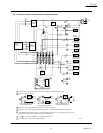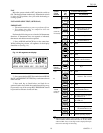
12
Installation
COMPATIBILITY
The T8611 Thermostats will replace most heat pump
system thermostats. As long as ac power is continuously
available to the thermostat, the thermostat will be compat-
ible with almost any low-volt control system.
WHEN INSTALLING THIS PRODUCT…
1. Read these instructions carefully. Failure to follow
them could damage the product or cause a hazardous
condition.
2. Check the ratings given on the product to make sure
the product is suitable for your application.
3. Installer must be a trained, experienced service tech-
nician.
4. Allow thermostat to warm to room temperature
before operating.
5. After installation is complete, check out product
operation as provided in these instructions.
CAUTION
Disconnect power supply to prevent electrical
shock or equipment damage.
LOCATION
Thermostat with Integral Sensor
Install thermostat and subbase about 5 ft. [1.5 m] above
the floor in an area with good air circulation at room
temperature.
Do not install the thermostat where it may be affected
by—
— drafts or dead spots behind doors, in corners or under
cabinets.
— hot or cold air from ducts.
— radiant heat from sun or appliances.
— concealed pipes and chimneys.
— unheated (uncooled) areas behind the thermostat,
such as an outside wall.
Thermostat with Remote-Mounted Sensor
Install thermostat in an area that is accessible for setting
and adjusting the temperature and settings.
Install remote temperature sensor in an area with good
air circulation at average temperature.
Do not install the sensor where it may be affected by—
— drafts or dead spots behind doors, in corners, or
under cabinets.
— hot or cold air from ducts.
— radiant heat from sun or appliances.
— concealed pipes and chimneys.
— unheated (uncooled) areas behind the sensor, such
as an outside wall.
IF REPLACING AN EXISTING THERMOSTAT
Turn thermostat power off at furnace or heat pump.
This thermostat requires a single transformer. A two-
transformer system may require turning off two switches
or disconnects, and rewiring to run the thermostat from a
single transformer. Make sure the transformer has ad-
equate power (VA) for the heating/cooling control system.
Add current ratings of the system components (such as
auxiliary heat relay, changeover relay, fan relay). Multiply
this total by 24V to determine transformer VA required.
Remove any existing wallplate or subbase from wall.
Label or write down each wire color with the letter or
number on the wiring terminal as the wire is removed to
avoid miswiring later.
IF NEW INSTALLATION
Run cable to a hole at the selected wall location for
thermostat and remote sensor, and pull about 3 in. [76 mm]
of wire through the opening. Color-coded, 18-gauge ther-
mostat cable with at least one conductor for each wiring
terminal is recommended. Good service practice recom-
mends selecting cable with one or two more conductors
than the immediate application requires.
If using thermostat model with remote temperature
sensing, run 3-wire, 18-gauge thermostat cable from the
thermostat location to the sensor location (200 ft. [61 m]
maximum). Route cable away from sources of electrical
noise.
MOUNTING SUBBASE
IMPORTANT: Set the subbase system switch in the OFF
position before mounting.
The subbase does not require leveling for operation, but
for appearance only.
Remove thermostat from subbase (Fig. 4).
!
T8611M
INSTALLATION


















